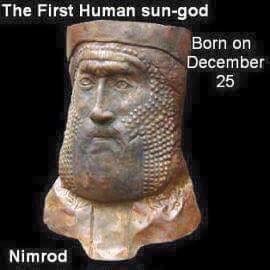
Christmas
Religion
[How do you get X from Christ?]
Xmas
X
See: St. Valentine’s Day Halloween Satanic sacrificial days Thanksgiving
Psychedelics And The Origins Of Christmas Folklore: An Interview With Professor Carl Ruck - Reset.me When you line up all the evidence, it's not so far fetched to think that our modern-day symbols Christmas echo a psychedelic past.

Nimrod, who was born on December 25th, the
High Sabbath of Babylon, was the founder of Babylon and the city of Nineveh. In the history of
mankind, Nimrod stands unequalled for his symbolism of evil and Satanic
practices. He is credited for having founded Freemasonry and for building the
legendary Tower of Babel, in defiance of God's will. In talmudic literature, he
is noted as "he who made all the people rebel against
God." Pes. 94b. The legend of the Midrash recounts that when Nimrod was informed
of Abraham's birth, he ordered all the male children killed, to be certain of
eliminating him. Abraham was hidden in a cave, but in latter life he was
discovered by Nimrod, who then ordered him to worship fire. Abraham refused and
was thrown into the fire.
The legendary symbol for Nimrod is
"X." The use of this symbol always denotes witchcraft. When "X" is used as a
shortened form meaning Christmas, it actually means "to celebrate the feast of
Nimrod." A double X, which has always meant to double-cross or betray, in its
fundamental meaning indicates one's betrayal into the hands of Satan. When
American corporations use the "X" in their logo, such as "Exxon," the historic
Rockefeller firm of Standard Oil of New Jersey, there can be little doubt of
this hidden meaning.
The importance of Nimrod in any
study of the occult cannot be over-emphasized. Because of the powers given him
by the clothing of Adam and Eve, Nimrod became the first man to rule the whole
world. He indulged that power by launching excesses and horrors which have never
been equalled. Ever since the time of Nimrod, Babylon
has been the symbol of depravity and lust. Nimrod also introduced the practice
of genocide to the world. His grandfather, Ham, having consorted with other
races, and brought children of mixed race into the world, was persuaded by his
consort, the evil Naamah, to practice ritual murder and cannibalism. She
informed Ham that by killing and eating fair-skinned people, his descendants
could regain their superior qualities. Throughout the ensuing centuries, the
fair-skinned descendants of Shem, Noah's oldest son, have ritually been
slaughtered by the darker descendants of Ham and Nimrod, in the world's most
persistent campaign of racial and religious persecution. Not only did Nimrod
kill and eat the fair-skinned descendants of Shem, in his fury and hatred he
often burned them alive. The type of human sacrifice involving the eating of the
slaughtered human victims derived its name from the combined names of his uncle,
Canaan, and the demon god Baal, the two names being combined to form the word
"cannibal." Nimrod was also known in ancient history by the names of Marduk, Bel,
and Merodach. Because of his importance in its history, Babylon was known as the
Land of Nimrod. Nimrod is also cited in the most ancient Masonic constitutions
as the founder of Freemasonry.
The Curse Of Canaan: A
Demonology Of History by Eustace Mullins
[1853] The Two Babylons or The Papal Worship Proved to be the Worship of
Nimrod and His Wife By the Late Rev. Alexander Hislop
The festivals of Rome are
innumerable; but five of the most important may be singled out for elucidation--viz.,
Christmas-day, Lady-day, Easter, the Nativity of St. John, and the Feast of the
Assumption. Each and all of these can be proved to be Babylonian. And first, as
to the festival in honour of the birth of Christ, or Christmas. How comes it
that that festival was connected with the 25th of December? There is not a word
in the Scriptures about the precise day of His birth, or the time of the year
when He was born. What is recorded there, implies that at what time soever His
birth took place, it could not have been on the 25th of December. At the
time that the angel announced His birth to the shepherds of Bethlehem, they were
feeding their flocks by night in the open fields. Now, no doubt, the climate of
Palestine is not so severe as the climate of this country; but even there,
though the heat of the day be considerable, the cold of the night, from December
to February, is very piercing, and it was not the custom for the
shepherds of Judea to watch their flocks in the open fields later than
about the end of October.
....How,
then, did the Romish Church fix on December the 25th as Christmas-day? Why,
thus: Long before the fourth century, and long before the Christian era itself,
a festival was celebrated among the heathen, at that precise time of the
year, in honour of the birth of the son of the Babylonian queen of heaven; and
it may fairly be presumed that, in order to conciliate the heathen, and to swell
the number of the nominal adherents of Christianity, the same festival was
adopted by the Roman Church, giving it only the name of Christ.
http://philologos.org/__eb-ttb/sect31.htm